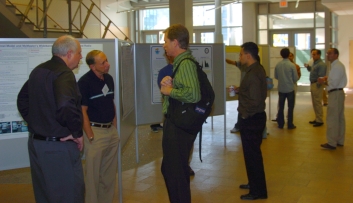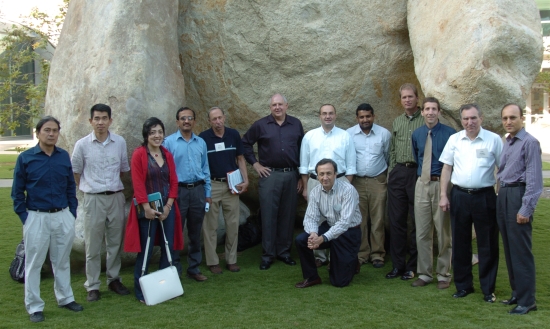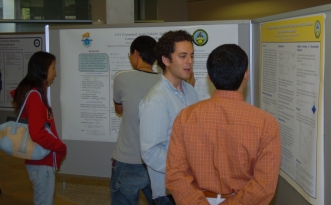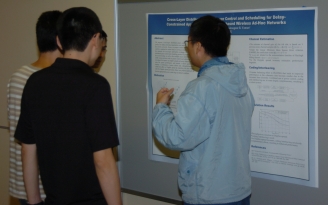MURI Space-Time Processing for Mobile Ad-Hoc Networks Project Celebrates Second Birthday
|
San Diego, CA, September 22, 2006 -- The Multi-University Research Initiative (MURI) Space-Time Processing for Tactical Mobile Ad-Hoc Networks Project held a day-long meeting of presentations and posters last Thursday at UCSD, as part of their 2006 annual review. Calit2-affiliated researchers from UCSD and UC Irvine were among those reporting strong progress two years into the research project.
"It went very well," said James Zeidler, the principal investigator (PI) for the project. "The feedback was excellent." Zeidler, a Calit2-affiliated researcher, is also a Research Scientist and Senior Lecturer in the UCSD Jacobs School of Engineering's Electrical and Computer Engineering department. Other Calit2-affiliated faculty on the project include UC Irvine professor Hamid Jafarkhani, as well as UCSD electrical engineering professors Rene Cruz, Tara Javidi, Laurence Milstein and Bhaskar Rao.
The Department of Defense (DoD) supports a number of MURI multidisciplinary projects each year in areas of importance to the DoD, and the UCSD-based project is specifically funded by the U.S. Army Research Office. Space-time processing techniques are used to maximize performance, in this case for multiple-antenna wireless communication nodes.
The scientific and technical accomplishments of the past year include more than a hundred published papers, numerous awards for best publications in IEEE journals and professional conferences and eight provisional patents. Four provisional patents are for the use of space-time coding to allow dual-antenna transmission from maneuvering air vehicles. An additional four provisional patent applications for advances in space-time coding and network synchronization are in process.
Investigators on the project won both the IEEE 2006 Stephen O. Rice Prize in for the best published IEEE journal paper in communications theory, the 2006 IEEE Signal Processing Society Award for the best IEEE journal paper in signal processing, and the 2006 IEEE Marconi Prize Paper Award for the best IEEE journal paper in wireless communications. In addition, the investigators on this project received four Best Paper Awards at engineering conferences during the past year. Two of the investigators were also elected to Fellow status in the IEEE this year.
Researchers on the project wrote 112 papers in all; 20 were published or accepted for publication in IEEE professional journals, 64 appeared in conference publications and 28 additional manuscripts have been submitted for journal review. (A link to the publications page is below.) Seven of the investigators collaborated on a paper that described some of the technical challenges of this project; that paper was published in the August issue of the IEEE Wireless Communications magazine.
The home base for this project is UC San Diego. Six universities in all are participating: four UC campuses (San Diego, Irvine, Riverside and Santa Cruz), as well as Brigham Young University (BYU) in Provo, Utah and McMaster University in Hamilton, Ontario. The project is affiliated with both the UCSD and UCI divisions of Calit2 and the UCSD Center for Wireless Communications.
Joining the six Calit2-affiliated researchers mentioned above are seven other co-principal investigators: John Proakis and Michele Zorzi of UCSD; Yingbo Hua and Srikanth Krisnamurthy of UCR; J.J. Garcia-Luna-Aceves of UCSC; Mike Jensen and Lee Swindlehurst of BYU; and Simon Haykin of McMaster University. Zorzi is also affiliated with the University of Padova in Italy.
|
The goal of the project is to improve the overall performance of ad hoc communication networks through the use of multiple antennas at each node of the network. Ad hoc networks are used for deployable systems where you cannot set up base stations, nor rely on a fixed infrastructure, such as military applications and emergency services. Decentralized control is important for tactical operations when one cannot count on their mobile infrastructure to survive, since, for example, critical nodes can become targets for jamming and/or physical destruction.
"Consequently, you need a distributed, ad-hoc network," noted Zeidler, "where your structure is embedded throughout the network. This is also very useful for disaster situations." These networks can be self-organizing and self-sustaining.
How this can best be achieved is a complex problem. "The key technical goal of this project is to define the gains that could be realized by employing more antennas at each of the nodes of the network, whether it's a phone, laptop, or vehicle," explained Zeidler. Multiple antennas can provide a lot of additional throughput by providing parallel links between the nodes, but can also be used for different things: to increase the data rate, to increase the robustness of the network, or to reduce the level of interference. There are performance tradeoffs depending on how the antennas are used.
|
In addition, there is the fundamental problem that the interference level increases as you add more nodes to the network: Engineers must determine how to control the transmissions at the nodes so they do not talk over each other. "The question being asked is how you use antenna elements," explained Zeidler. "There are several layers in a network model: the physical layer, link layer, medium access layer, network layer and applications layer. The antennas are in the physical layer, therefore you need to work through the layers in order to say how we are going to use these elements to provide performance improvements in the higher layers of the network."
"This fundamentally makes our objective the solution of a cross-layer networking problem," Zeidler added. People tend to be experts in different layers, as each requires a different skill set. According to Zeidler, "solving the problem requires a coordinated effort of people with different skill sets. We have investigators with expertise in all these layers, and our ultimate success or failure will be determined by how well we are able to coordinate our individual efforts"
"There is a huge advance in the amount of collaboration that's been going on," observed Tricia Willink, a research scientist with the Communications Research Centre Canada, a Canadian federal research lab. "People are really taking the expertise from PIs in other areas and applying it to what they are doing. I think the advance from that is really noticeable." She attended and took part in the review process last year "because we are sponsoring some of Simon Haykin's work at McMaster University, and he is a member of this MURI project. I came again this year because it was good last year
Michael Larsen, a BYU Ph.D. graduate student also attended last year, was happy to see "the ties coming together" this year. He said: "It was neat to see the collaborations between different professors and between professors and students."
The meeting featured nearly a dozen presentations on each of the various efforts at the six universities. There were two poster sessions to cover the two dozen posters. The talks covered not just the past year's work, but also included preliminary results of current work and where it may be leading to new technologies. Participants were impressed with the high quality of the talks.
|
"I have not seen a forum of this type at this level anywhere else. There was a focused day of presentations that were all very high quality. That gets your brain moving in a way that I have not experienced much at some of the conferences," said Geoff Colman who is a research engineer with the Communications Research Centre.
The program manager for the project, Robert Ulman of the U.S. Army Research Office, was also impressed. He said he "was very pleased with the presentations, and happy with the meeting."
There were more than 60 attendees, including participants from outside the project. These included other Calit2 researchers, industry representatives from Intel, QUALCOMM, Raytheon, Samsung Electronics and ViaSat, as well as from SPAWAR Systems Center, San Diego and Canada's Communications Research Centre in Ottawa. .
"Fundamentally, it depends greatly on the how well the network can access information from the communications channels that govern the performance of each of the individual links between the nodes in the network. The links often change rapidly, particularly in an ad hoc mobile network with vehicles, and potentially aircraft involved. How you select and maintain your links and keep them updated requires information about the channels and they change when you move," Zeidler concluded. "No one knows exactly how to do this. That is a big part of what we are doing."
Related Links
MURI Space-Time Processing for Mobile Ad-Hoc Networks Project
MURI Annual Review Meeting 2006
Project Publications
UCSD Center for Wireless Communications
Army Research Office
Multidisciplinary Research Program of the University Research Initiative (MURI)
SPAWAR Systems Center
UCI Center for Pervasive Computing and Communications
UC Riverside
UC Santa Cruz
Brigham Young University
McMaster University




